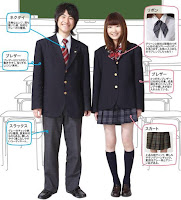Japanese students take their shoes off to keep the school clean. The reasons and significance for this have to do with teaching students responsibility and respect. To this end, Japanese public schools do not employ janitors or custodians. Keeping the school clean is the students' responsibility.
It's common knowledge that Japanese people remove their shoes before entering a home in order to protect the bamboo floor mats, or tatami, from soil and wear. What is less commonly known is that they follow the same custom when entering certain public buildings, even though such buildings may have no tatami flooring. When entering a public school, everyone -- students, teachers, employees and visitors -- take off their shoes just inside the entrance and put on slippers or special indoor shoes, regardless of status or authority. In this way, taking off shoes acts as an "equalizer." Japanese public schools do not employ janitors. The Japanese education system believes that requiring students to clean the school themselves teaches respect and responsibility.
One of the more intriguing results of making students responsible for maintaining a clean school is that with no janitors to clean up after them, students in Japan do not learn any of the condescension for janitors, custodians or cleaning staff that is common in many other countries. By having students clean schools themselves, students do not see themselves as "above" such work.
Students remove their shoes at the entrance of the school. They place their outdoor shoes in a small, square shelf called a "geta bako" and put on "uwagutsu," or indoor slippers. The "geta bako," or shoe box, is used for storing shoes, but it doubles as a kind of informal letter box in which notes for the student can be left. Students in Japan do not have lockers of their own. These shoe boxes are the closest students come to having a private place to keep their personal effects. Many people, however, consider the "geta bako" dirty from the shoes and avoid leaving notes or other effects there.
The uwagutsu tend to be soft canvas tops with rubber soles. These indoor slippers protect the students' socks from unnecessary wear and tear, provide extra traction on the linoleum floors, and provide a little extra warmth in winter in unheated classrooms.
Every public -- and almost all private -- schools in Japan requires students to wear uniforms. In Japan, the requirement that all students wear a school uniform is meant to enforce a sense of equality and teamwork among students, to ban the public exhibition of status symbols such as fashionable clothing, and limit in-school distractions to education. The use of indoor shoes and slippers is another means of enforcing a uniform dress code. It should be noted, however, that students do not view this as a requirement, as taking off one's shoes before entering school is simply what people do.
Source : http://www.ehow.com/




Comments
Post a Comment